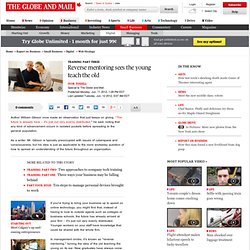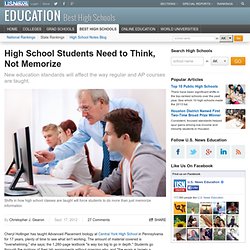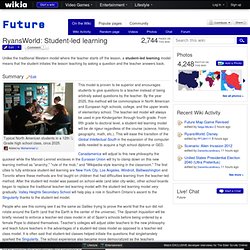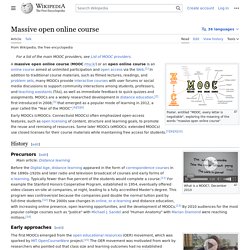

MITx: Big Data and Social Physics: MAS.S69x About Video. MAS.S69x: Big Data and Social Physics. SMART Boards Why are they so easy to use? Education. Education Week. Reverse mentoring sees the young teach the old. Author William Gibson once made an observation that just keeps on giving.

“The future is already here – it’s just not very evenly distributed,” he said, noting that any kind of advancement occurs in isolated pockets before spreading to the general population. As a writer, Mr. Gibson is typically preoccupied with issues of cyberspace and consciousness, but his idea is just as applicable to the more workaday question of how to spread an understanding of the future throughout an organization. If you’re trying to bring your business up to speed on online technology, you might find that, instead of having to look to outside agents such as colleges or business schools, the future has already arrived at your firm – it’s just not very evenly distributed. Younger workers on your staff have knowledge that could be shared with the whole firm. In management circles, it’s known as “reverse mentoring,” turning the idea of the old teaching the young on its ear.
High School Students Need to Think, Not Memorize. Cheryl Hollinger has taught Advanced Placement biology at Central York High School in Pennsylvania for 17 years, plenty of time to see what isn't working.

The amount of material covered is "overwhelming," she says; the 1,280-page textbook "is way too big to go in depth. " Students go through the motions of their lab assignments without grasping why, and "the exam is largely a vocabulary test. " That all changes this fall, however, with a new curriculum that lasers in on just three body systems (down from 11); requires fewer but more creative biology labs, and entails an AP exam assessing reasoning skills rather than factoid recall.
"I'm excited," says Hollinger, who welcomes the prospect of getting students "to think and act like scientists. " [Check out the rankings of the Best High Schools.] Students and parents, get set for the next wave of education reform, which is about to raise expectations. [Awareness is key to success of Common Core Standards.] Crowdsourced curriculum. David Wiley's Keynote on Open Education. Coursera. Student-led learning - Future. Unlike the traditional Western model where the teacher starts off the lesson, a student-led learning model means that the student initates the lesson teaching by asking a question and the teacher answers back.

Summary Edit This model is proven to be superior and encourages students to give questions to a teacher instead of being arbitraily asked questions by the teacher. By the year 2025, this method will be commonplace in North American and European high schools, college, and the upper levels of elementary school. The teacher-led model will always be used in pre-Kindergarten through fourth grade.
Colleges Assess Cost of Free Online-Only Courses. Massive open online course. Poster, entitled "MOOC, every letter is negotiable", exploring the meaning of the words "Massive Open Online Course" A massive open online course (MOOC /muːk/) is an online course aimed at unlimited participation and open access via the web.[1] In addition to traditional course materials such as filmed lectures, readings, and problem sets, many MOOCs provide interactive user forums to support community interactions among students, professors, and teaching assistants (TAs).

MOOCs are a recent and widely researched development in distance education which were first introduced in 2006 and emerged as a popular mode of learning in 2012.[2][3] Early MOOCs often emphasized open-access features, such as open licensing of content, structure and learning goals, to promote the reuse and remixing of resources. Some later MOOCs use closed licenses for their course materials while maintaining free access for students.[4][5][6][7] Is there a business model for MOOCs? Report from #emoocs2014. Panel discussion at #emoocs2014 with MOOCs providers MOOCs have just appeared and the big question has already been raised: are they sustainable?

In other words, are they pedagogically adequate, institutionally relevant and financially viable? MOOCs are rupturing the norms of how we have taught and learned until now. They enable a fresh approach to continuing education. They demonstrate the irrelevance of existing quality standards. One of the questions that comes up again and again refers to the business model. The cost of offering a MOOC I participated in a panel that gathered representatives from edX, Coursera and FutureLearn: three “platforms” delivering MOOCs and creating partnerships with some of the world’s leading universities. Costs of production of MOOCs are largely underestimated; a minimum of 30.000 Euros per MOOC seems to be the lowest acceptable figure. Why MOOCs need a model However, things also have to change on the revenue side. Potential business models.